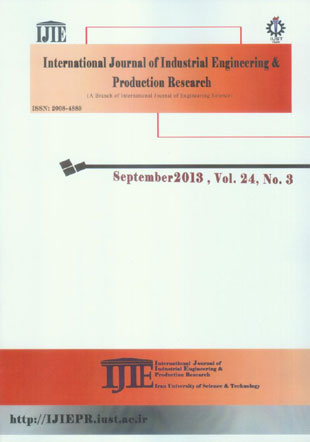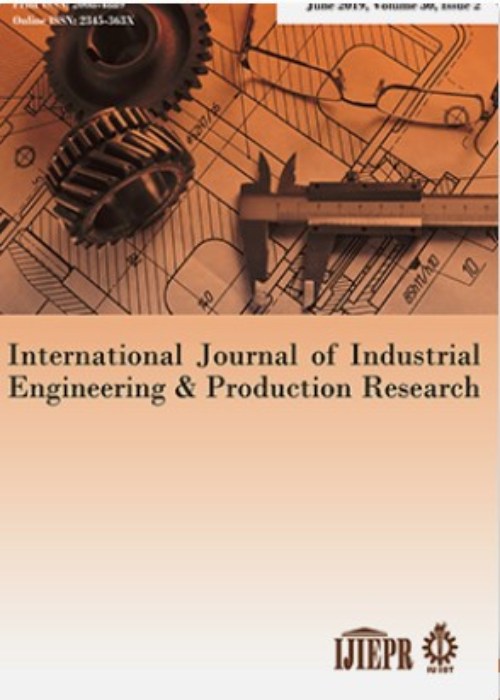فهرست مطالب

International Journal of Industrial Engineering and Productional Research
Volume:24 Issue: 3, Sep 2013
- تاریخ انتشار: 1392/07/23
- تعداد عناوین: 8
-
-
Pages 151-167Purpose of this paper: The objectives of this paper are two folds: (1) utilizing hierarchical fuzzy technique for order preference by similarity to ideal solution (TOPSIS) approach to evaluate the most suitable RFID-based systems decision, and (2) to highlight key risks and benefits of radio frequency identification technology in healthcare industry. Design/methodology/approach: Researcher explains the importance of selection criteria for evaluation of RFID-based system. It provides key elements on radio frequency identification, fuzzy hierarchical TOPSIS methodology and an algorithm that can be followed to solve the problem. A sample problem using the algorithm is solved and results are explained.FindingsThe hierarchical TOPSIS model used in this article is able to grasp the ambiguity exists in the utilized information and the fuzziness appears in the human judgments and preferences. The use of the hierarchical fuzzy TOPSIS methodology offers a number of benefits: (1) it is a systematic model and straight forward to work on; (2) capable to capture the human''s appraisal of ambiguity when management should deal with a complex multiple objective situations. The hierarchical fuzzy TOPSIS is in some way superior to the other Fuzzy multi criterion decision making techniques, such as fuzzy analytic hierarchy process (FAHP) and classical fuzzy TOPSIS methods. This is because while in the hierarchical structure no pair-wise comparisons among criteria, sub-criteria, and alternatives are necessary to be made, it is already being taken into consideration by the model. Hierarchical fuzzy. Practical implications (if applicable): What is original/value of paper: Due to the fact that a better management of health care system is related to the full understanding of the technologies implemented and the system under consideration, sufficient background on the radio frequency identification technology is provided and the RFID systems most likely management would face with and select one are provided for decisions to be made on them.Keywords: RFID Technology, RFID, based system selection, healthcare applications, hierarchical fuzzy TOPSIS
-
Pages 169-175In this research the sensitivity analysis of the geometric parameters such as: length, thickness and width of a single link flexible manipulator on maximum deflection (MD) of the end effector and vibration energy (VE) of that point are conducted. The equation of motion of the system is developed based on Gibbs-Appel (G-A) formulation. Also for modeling the elastic property of the system the assumption of assumed modes method (AMM) is applied. In this study, two theories are used to obtain the end-point MD and VE of the end effector. Firstly, the assumption of Timoshenko beam theory (TBT) has been applied to consider the effects of shear and rotational inertia. After that, Euler-Bernoulli beam theory (EBBT) is used. Then Sobol’s sensitivity analysis method is applied to determine how VE and end-point MD is influenced by those geometric parameters. At the end of the research, results of two mentioned theories are compared.Keywords: Euler, Bernoulli, Timoshenko, Sensitivity analysis, Sobol
-
Pages 177-187In this paper, we consider a stochastic Time-Cost Tradeoff Problem (TCTP) in PERT networks for project management, in which all activities are subjected to a linear cost function and assumed to be exponentially distributed. The aim of this problem is to maximize the project completion probability with a pre-known deadline to a predefined probability such that the required additional cost is minimized. A single path TCTP is constructed as an optimization problem with decision variables of activity mean durations. We then reformulate the single path TCTP as a cone quadratic program in order to apply polynomial time interior point methods to solve the reformulation. Finally, we develop an iterative algorithm based on Monte Carlo simulation technique and conic optimization to solve general TCTP. The proposed approach has been tested on some randomly generated test problems. The results illustrate the good performance of our new approach.Keywords: Project Management, Conic Optimization, Time, Cost Tradeoff Problem, Interior Point Methods, Monte Carlo Simulation
-
Pages 189-206This paper mainly focuses the study and analysis of the existing contributions related to the Biodiesel production. It, firstly, discuss the key issues related contributions which include chemical process, reactor designing, plantation, blending and applications. Next, it summarizes the analysis of the other prominent contributions related to process model, design, production, cost, optimization, feasibility, safety, effects, challenges and future of the Biodiesel. It also presents the discussion on the open issues in Biodiesel. Secondly, an approach is suggested for the design of the Biodiesel manufacturing plant in view of cost and capacity. The suggested approach is based on the mathematical model. This paper provides the brief study of Biodiesel production and plant design and it can be helpful to the beginners in the domain of renewable energy research.Keywords: Biodiesel, Production Plant Design, Design Issues, Mathematical Model
-
Pages 207-216Most of the researches in the domain of fuzzy number comparisons serve the fuzzy number ordering purpose. For making a comparison between two fuzzy numbers, beyond the determination of their order, it is needed to derive the magnitude of their order. In line with this idea, the concept of inequality is no longer crisp; however it becomes fuzzy in the sense of representing partial belonging or degree of membership. In this paper we propose a method for capturing the membership degree of fuzzy inequalities through discretizing the μ-axis into equidistant intervals. It calculates m in the fuzzy inequalities ≤ m and ≥m among two normal fuzzy numbers. In this method, the two μ-axis based discretized fuzzy numbers are compared point by point and at each point the degree of preferences is identified. To show its validity, this method is examined against the essential properties of fuzzy number ordering methods in [Wang, X. and E.E. Kerre, Reasonable properties for the ordering of fuzzy quantities (I). Fuzzy Sets and Systems, 2001. 118(3): p. 375-385.] The result provides promising outcomes that may be useful in the domain fuzzy multi criteria or multi-attribute decision making analysis and also fuzzy mathematical programming with fuzzy inequality constraints.Keywords: Fuzzy number comparison, Fuzzy inequality, Fuzzy number ordering
-
Pages 217-227Location-allocation of facilities in service systems is an essential factor of their performance. One of the considerable situations which less addressed in the relevant literature is to balance service among customers in addition to minimize location-allocation costs. This is an important issue, especially in the public sector. Reviewing the recent researches in this field shows that most of them allocated demand customer to the closest facility. While, using probability rules to predict customer behavior when they select the desired facility is more appropriate. In this research, equitable facility location problem based on the gravity rule was investigated. The objective function has been defined as a combination of balancing and cost minimization, keeping in mind some system constraints. To estimate demand volume among facilities, utility function(attraction function) added to model as one constraint. The research problem is modeled as one mixed integer linear programming. Due to the model complexity, two heuristic and genetic algorithms have been developed and compared by exact solutions of small dimension problems. The results of numerical examples show the heuristic approach effectiveness with good-quality solutions in reasonable run time.Keywords: Facility location, Equitable load, Gravity model, Heuristic algorithm, Genetic algorithm, Integer programming
-
Pages 229-235The quality of manufactured products is characterized by many controllable quality factors. These factors should be optimized to reach high quality products. In this paper we try to find the controllable factors levels with minimum deviation from the target and with a least variation. To solve the problem a simple aggregation function is used to aggregate the multiple responses functions then an imperialist competitive algorithm is used to find the best level of each controllable variable. Moreover the problem has been better analyzed by Pareto optimal solution to release the aggregation function. Then the proposed multiple response imperialist competitive algorithm (MRICA) has been compared with Multiple objective Genetic Algorithm. The experimental results show efficiency of the proposed approach in both aggregation and non aggregation methods in optimization of the nonlinear multi-response programming.Keywords: Multi, response Optimization, Imperialist competitive, Genetic Algorithm, Response surface methodology
-
Pages 237-246Allocation of construction risks between clients and their contractors has a significant impact on the total construction costs. This paper presents a system dynamics (SD)-based approach for quantitative risk allocation. Using the proposed SD based approach, all the factors affecting the risk allocation process are modeled. The contractor’s defensive strategies against the one-sided risk allocation are simulated using governing feedback loops. The full-impact of different risk allocation strategies may efficiently be modeled, simulated and quantified in terms of time and cost by the proposed object-oriented simulation methodology. The project cost is simulated at different percentages of risk allocation and the optimum percentage of risk allocation is determined as a point in which the project cost is minimized. To evaluate the performance of the proposed method, it has been implemented in a pipe-line project. The optimal risk allocation strategy is determined for the inflation risk as one of the most important identified risks.Keywords: Modeling, risk allocation, simulation, system dynamics


